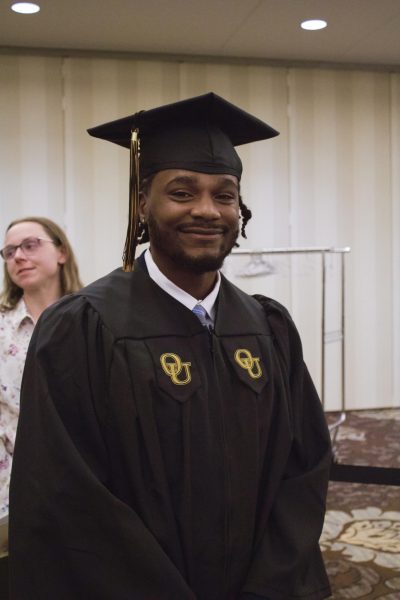Rare books librarian connects with students
Oakland University’s first rare book librarian, Emily Spunaugle, was introduced in October 2019. Although a coordinator of archives and special collections oversees all the archival materials and rare books, Spunaugle is the first to specifically direct the rare books only.
She felt this was a great position for her since she is also currently working toward her doctorate in book history at Wayne State University.
Collections she takes care of includes, the Springer Collection — which is about Abraham Lincoln — collections of local history material dating back to the 19th century and the Marguerite Hicks Collection, which is women’s writing from the 17th-19th centuries.
“It’s so exciting to watch students, or anybody when they touch a rare book or something from the ’60s or ’70s. You’re the one touching it, and you can see, ‘oh this is the hand made paper,’” Spunaugle said. “You’re opening a book but it’s like a portal into another time and place, but it’s also very familiar because we still have books.”
The Marguerites Hicks Collection is one Spunaugle works with a lot and tries to introduce to students often. At the moment, she is a co-director of the Marguerite Hicks Project along with Dr. Megan Peiser. They are doing research on this collection to better understand the reasoning behind the writings and original collector, Marguerite Hicks.
Spunaugle has further plans for the rare book room. They are in the process of getting grants to improve the environmental conditions for the books from the National Endowment for the Humanities (NEH) and The NorthEast Document Conservation Center (NEDCC). She makes sure that each book is in the most ideal situation to make them last as long as possible.
Moving forward she wants to encourage students, faculty and visitors to interact more with the rare books. She tries to incorporate them into classes, her own and other instructors’.
“The most exciting part of this role, that I have and that I’ve been able to do so far, is finding ways to get these books into the hands of students,” Spunaugle said. “[I’ll use] any excuse to get students to touch and handle properly and experience these older books, or these books you wouldn’t be able to just pull off a shelf or see everyday.”
Spunaugle just finished working on two articles, coming out this fall, about a book in the rare book collection with only one copy in the world. The book is “Mary, the Osier Peeler,” which is a short poem from 1798.
“From doing research, I was able to determine who the author was, and I learned a lot about her family and the fact that she wrote this poem and sold it so she could help support a really, really poor family,” Spunaugle said.
One article that she has coming out will talk about how the unknown author that she has identified is actually known in other genres of writing, such as travel. Spunaugle puts the information of the two writing styles together to better understand the author.
The second article will be a scholarly edition,an introduction to the poem and explanations to words that could be misunderstood to a 21st century reader.
Spunaugle is not yet ready to start her dissertation, but her research will be focused on women’s writings that were unpublished.
“The thing that I’m most interested in is women that paid for their books to be published or printed,” Spunaugle siad.
She wants to look further into the women that didn’t want to go the traditional route of going through a publisher and instead just paid for about 200 copies to be made to pass among their friends and peers.
“That’s something that I’m interested in looking at. To see why they would do that, how it worked[and] who’d they send it to,” Spunaugle said. “[I want to] just get a better sense of this phenomenon that we know happened but we haven’t spent a lot of time researching it.”







